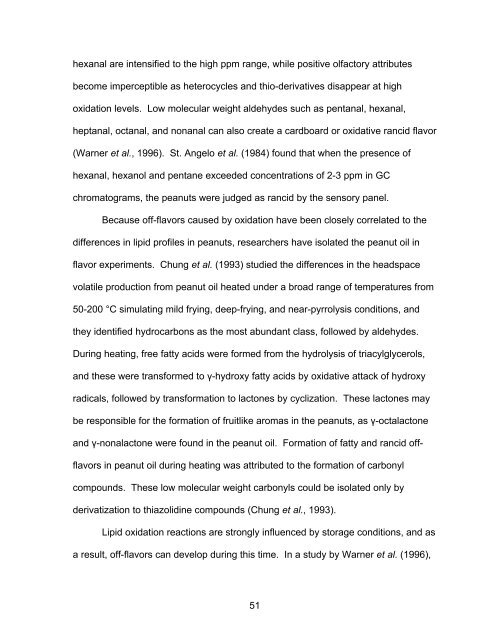Abstract SCHIRACK, ANDRIANA VAIS. The Effect of Microwave ...
Abstract SCHIRACK, ANDRIANA VAIS. The Effect of Microwave ...
Abstract SCHIRACK, ANDRIANA VAIS. The Effect of Microwave ...
You also want an ePaper? Increase the reach of your titles
YUMPU automatically turns print PDFs into web optimized ePapers that Google loves.
hexanal are intensified to the high ppm range, while positive olfactory attributes<br />
become imperceptible as heterocycles and thio-derivatives disappear at high<br />
oxidation levels. Low molecular weight aldehydes such as pentanal, hexanal,<br />
heptanal, octanal, and nonanal can also create a cardboard or oxidative rancid flavor<br />
(Warner et al., 1996). St. Angelo et al. (1984) found that when the presence <strong>of</strong><br />
hexanal, hexanol and pentane exceeded concentrations <strong>of</strong> 2-3 ppm in GC<br />
chromatograms, the peanuts were judged as rancid by the sensory panel.<br />
Because <strong>of</strong>f-flavors caused by oxidation have been closely correlated to the<br />
differences in lipid pr<strong>of</strong>iles in peanuts, researchers have isolated the peanut oil in<br />
flavor experiments. Chung et al. (1993) studied the differences in the headspace<br />
volatile production from peanut oil heated under a broad range <strong>of</strong> temperatures from<br />
50-200 °C simulating mild frying, deep-frying, and near-pyrrolysis conditions, and<br />
they identified hydrocarbons as the most abundant class, followed by aldehydes.<br />
During heating, free fatty acids were formed from the hydrolysis <strong>of</strong> triacylglycerols,<br />
and these were transformed to γ-hydroxy fatty acids by oxidative attack <strong>of</strong> hydroxy<br />
radicals, followed by transformation to lactones by cyclization. <strong>The</strong>se lactones may<br />
be responsible for the formation <strong>of</strong> fruitlike aromas in the peanuts, as γ-octalactone<br />
and γ-nonalactone were found in the peanut oil. Formation <strong>of</strong> fatty and rancid <strong>of</strong>f-<br />
flavors in peanut oil during heating was attributed to the formation <strong>of</strong> carbonyl<br />
compounds. <strong>The</strong>se low molecular weight carbonyls could be isolated only by<br />
derivatization to thiazolidine compounds (Chung et al., 1993).<br />
Lipid oxidation reactions are strongly influenced by storage conditions, and as<br />
a result, <strong>of</strong>f-flavors can develop during this time. In a study by Warner et al. (1996),<br />
51

















